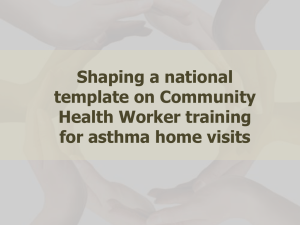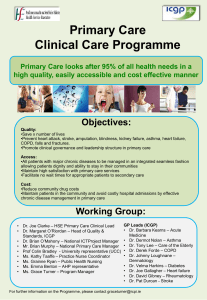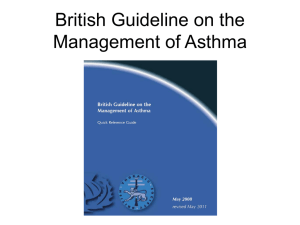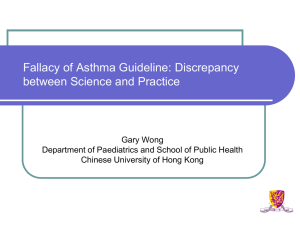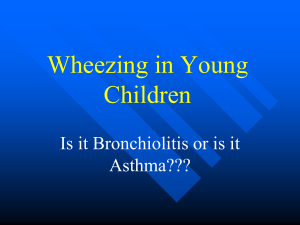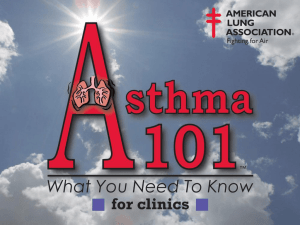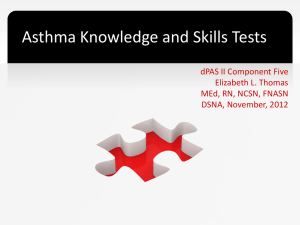Asthma Control Backgrounder - Global Initiative for Asthma
advertisement
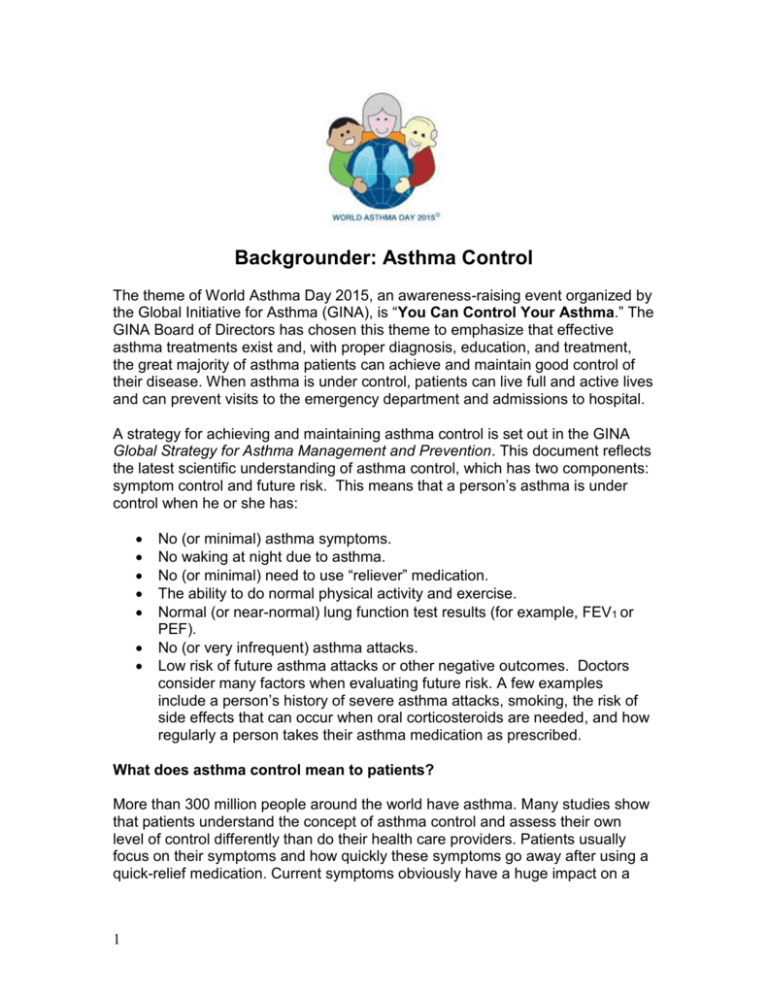
Backgrounder: Asthma Control The theme of World Asthma Day 2015, an awareness-raising event organized by the Global Initiative for Asthma (GINA), is “You Can Control Your Asthma.” The GINA Board of Directors has chosen this theme to emphasize that effective asthma treatments exist and, with proper diagnosis, education, and treatment, the great majority of asthma patients can achieve and maintain good control of their disease. When asthma is under control, patients can live full and active lives and can prevent visits to the emergency department and admissions to hospital. A strategy for achieving and maintaining asthma control is set out in the GINA Global Strategy for Asthma Management and Prevention. This document reflects the latest scientific understanding of asthma control, which has two components: symptom control and future risk. This means that a person’s asthma is under control when he or she has: No (or minimal) asthma symptoms. No waking at night due to asthma. No (or minimal) need to use “reliever” medication. The ability to do normal physical activity and exercise. Normal (or near-normal) lung function test results (for example, FEV1 or PEF). No (or very infrequent) asthma attacks. Low risk of future asthma attacks or other negative outcomes. Doctors consider many factors when evaluating future risk. A few examples include a person’s history of severe asthma attacks, smoking, the risk of side effects that can occur when oral corticosteroids are needed, and how regularly a person takes their asthma medication as prescribed. What does asthma control mean to patients? More than 300 million people around the world have asthma. Many studies show that patients understand the concept of asthma control and assess their own level of control differently than do their health care providers. Patients usually focus on their symptoms and how quickly these symptoms go away after using a quick-relief medication. Current symptoms obviously have a huge impact on a 1 person’s quality of life. However, other aspects of asthma control are also important for health care providers to monitor, and for patients to understand. What does asthma control mean to health care providers? The GINA Global Strategy for Asthma Management and Prevention recommends that health care providers describe asthma control in terms of both symptom control and future risk. For example: Ms. X has good asthma symptom control, but she is at increased risk of future exacerbations because she has had a severe asthma attack within the last year. Mr. Y has poor asthma symptom control. He also has several additional risk factors for future asthma attacks including low lung function, current smoking, and poor medication adherence. How do health care providers assess asthma control? To assess a patient’s level of asthma control, a health care provider will begin by asking about the person’s symptoms over the last month or so. This gives information about current symptom control, and also informs future risk because worsening asthma symptoms increase the risk for asthma attacks, also known as exacerbations or flare-ups. Other factors that increase the risk for asthma flare-ups — even if a person currently has few symptoms — include having had one or more exacerbations in the past year, not regularly taking asthma medication as prescribed, using an asthma inhaler incorrectly, and smoking. Exacerbations are one of the most important negative outcomes that fall under the heading of ‘future risk.’ Others include the risk of developing irreversible lung function abnormalities and the risk of side effects from oral corticosteroids (which may be needed to treat exacerbations that can occur when safe inhaled medications are not taken regularly). Lung function and asthma control Lung function testing is an important part of the assessment of future risk. The most reliable way of assessing lung function is spirometry, a brief, painless test performed in a doctor’s office or lung function laboratory that measures a patient’s forced expiratory volume in one second (FEV1). In individuals with poor asthma control, FEV1 can be lower than normal, reflecting the fact that their airways are inflamed and air does not move easily into and out of the lungs. While access to lung function testing is lacking in some parts of the world, ideally a patient’s lung function should be measured at the start of treatment, after 3–6 2 months of treatment (to identify the patient’s personal best lung function), and periodically thereafter for ongoing assessment of asthma control. Asthma Control and the Burden of Asthma Around the world, asthma imposes a heavy burden on individuals, families, and the broader community. The Global Burden of Asthma Report, a compilation of published data on the prevalence and impact of asthma around the world, indicates that asthma control often falls short and there are many barriers to asthma control in different regions. The Global Burden of Asthma Report was released by the Global Initiative for Asthma (GINA) on World Asthma Day 2004, and remains one of the most comprehensive current assessments of the burden of asthma worldwide. Proper long-term management of asthma will permit most patients to achieve good control of their disease. Yet the Global Burden of Asthma Report documents ample evidence that, in many regions around the world, this goal is often not met: Hospitalizations, emergency room visits, and other urgent care occur when a person’s asthma is not under good control. Although the rates of these medical visits generally increase as the prevalence of asthma rises, the very high proportions of people with asthma who require such care in many countries is an indication that lack of control is widespread. Poor asthma control is also seen in the lifestyle limitations experienced by some people with asthma. In some areas significant numbers of children with asthma are unable to attend school regularly because of poor asthma control. Asthma deaths are the ultimate, tragic evidence of uncontrolled asthma. According to the Global Burden of Asthma Report, the majority of asthma deaths in many regions of the world are preventable. What are the Barriers to Asthma Control? Although the barriers to asthma control vary from country to country and from region to region around the world, the Global Burden of Asthma Report identifies several patterns: 3 Diagnosis. Some people with asthma symptoms may never receive a diagnosis of asthma. Various factors such as poor access to medical care, under recognition by health professionals, lack of awareness among patients, and overlap of asthma symptoms with those of other diseases contribute to under diagnosis of asthma in many regions. Treatment. Barriers relating to treatment are the most commonly cited in the Global Burden of Asthma Report, occurring in one form or another in almost all regions around the world. These include the high cost of medicines; the fact that asthma medications are not available in some areas; treatment that is not consistent with evidence-based guidelines, especially the underuse of inhaled corticosteroids for long-term management of asthma; a general lack of access to medical care; lack of asthma education; and environmental health challenges such as outdoor or indoor air pollution. 4
